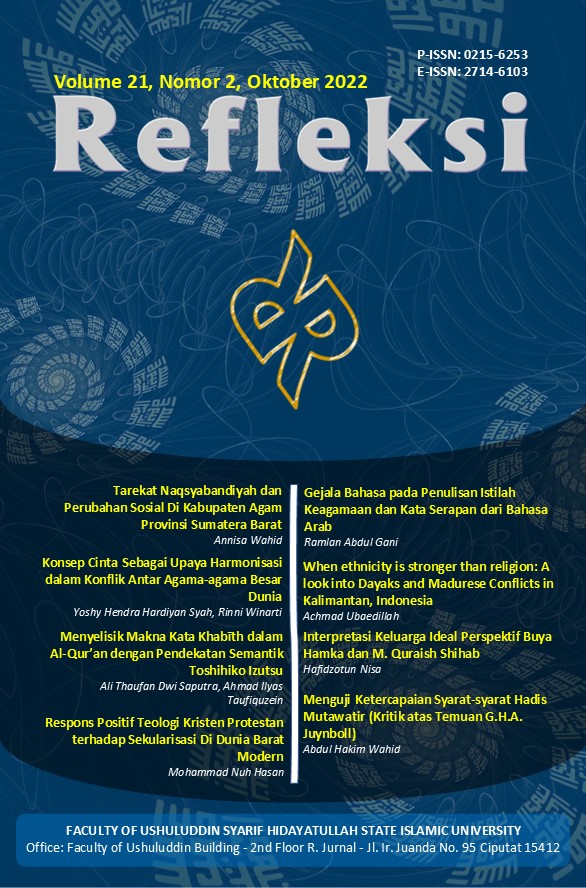Tarekat Naqsyabandiyah dan Perubahan Sosial Di Kabupaten Agam Provinsi Sumatera Barat
DOI:
https://doi.org/10.15408/ref.v21i2.29208Keywords:
Naqsyabandiyah Order, Social Change, Lasi VillageAbstract
This research is the social changes that occurred in the Naqsyabandiyah order in Agam, West Sumatera. This study examines how the appearance of the disappearance of the Naqsyabandiyah order in Lasi Tuo and the survival of the Naqsyabandiyah order in Lasi Mudo, Agam recency, West Sumatera wich focuses on three things, namely the first history of the emergence of the Naqsyabandiyah order in Lasi Tuo and Lasi Mudo. The two, factors that cause the Naqsyabandiyah congregation to disappear in the drawer of the body and survive in Lasi Mudo. The third, knowing the impact of disappearing and asking the Naqsyabandiyah congregation on social stability. The tarekat will will experience changes in the sense that the tarekat will no longer exist due to several things, namely the absence of a teacher figure, no congregation, and economi factor. The method used in this study is a field research method with a type of qualitative research obtained based on the results of interview observations and documentation. This study uses a sociological approach. The theory used in this study is August Comte theory of social change. The results of this study indicate that a Naqsyabandiyah order first appeared in Lasi, Agam, West Sumatera in 1970 brought by three major ulama, namely Sheikh Damanhuri, Muhammad Zen and Jamaan Ahmad. The cause of the existence or not of an tarekat can be seen from the following four factors, namely the existence of a teacher figure or an tarekat figure, the presence of an order congregation, the seclusion house used as a place of study for the tarekat, economi factor and the conflict that occurs between tachers, students and the community. The disappearance of the Naqsyabandiyah order in Lasi Tuo and the survival of the tarekat in Lasi Mudo, Agam, West Sumatera have an impact on the emergence of the Syattariyah order in drawer two which makes the community divided into two groups.
References
Alba, Cecep. Tasawuf dan Tarekat Dimensi Esitoris Ajaran Islam. Surabaya: Remaja Rosda Karya, 2009.
Algar, Hamid. Tarekat Naqsyabandiyah di Indonesia. Jakarta: UIN Syarif Hidayatullah, 2020.
Asgil. Eksistensi Tarekat Naqsyabandiyah di Surau Baru Kecamatan Pauah Kota Padang. Padang: UNAND, 2012.
Bakar, Abu. Pengantar Ilmu Tarekat. Solo: Ramadhani, 2012.
Hartati, Dinamika Tarekat Naqsyabandiyah dan Perubahan Sosial di Slemanan Kabupaten Blitar. Surabaya: UIN Sunan Ampel, 2016.
Iskandar, Joni. Tarekat Naqsyabandiyah di Desa Medan Jaya kota Bengkulu. Bengkulu: IAIN Bengkulu, 2010.
Khadijah, Siti. Perkembangan Tarekat Naqsyabandiyah di Pekalongan. Pekalongan: IAIN Pekalongan, 2016.
Martono, Nanang. Sosiologi Perubahan Sosial. Bandung: Rajawali Pers, 2012.
Mulyati, Tasawufisme di Indonesia. Bandung: Bulan Bintang, 2005.
Ni’am, Syamsun, Tarekat Naqsyabandiyah di Tengah Perubahan Sosial. Aceh: UIN Arraniry, 2015.
Nurjana, Tinjauan Konflik di Indonesia. Jakarta: Jurnal UIN Syarif Hidayatullah, 1994.
Pismawenzi. Tarekat Naqsyabandiyah dan Pembinaan Mental Remaja. Padang: UIN Imam Bonjol Padang, 2015.
Samsudin, Perkembangan Tarekat Naqsyabandiyah di Desa Medan Jaya Kota Bengkulu. Bengkulu: Universitas Bengkulu, 2006.
Syukur, Amin. Intelektualisme Tasawuf. Semarang: Pustaka Pelajar, 2002.
Siregar, Hidayat. Tarekat Naqsyabandiyah Syekh Abdul Rokan, Medan: UINSU, 2011.
Sulistiana, Ivan. Tarekat Syattariyah dan Perubahan Sosial di Cirebon, Bengkulu: IAIN Bengkulu, 2012
Supatman, Kholil. Dinamika Tarekat di Indonesia. Jakarta: Gramedia, 2000.
Wijono, Konflik dalam Organisasi. Jakarta: Satya Wacana, 1993.








